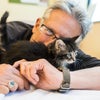People like me (with long careers spent working with animals) on occasion find ourselves amused watching academics and other career scientists postulate and then attempt to objectively prove stuff we've long known to be true about animals. We know, for example, that dogs are smart and do in fact love us rather than just manipulate us for food. We know that cats are highly social animals. We know that crows play. Scientists have proven all of that to be true, although we're not sure why they felt the need to do so since it looks a lot like proving that there is in fact a nose at the end of my face. Hey, everyone has to earn a living.
That being said, a good friend just sent me a paper proving something to be true that I had never stopped to wonder about, and I'm getting a big kick out of it. The paper is "Unexpected behavior in the Cretaceous: tooth-marked bones attributable to tyrannosaur play" (written by Bruce M. Rothschild, published in the most recent edition of Ethology Ecology & Evolution)
The article is a bit of a slog for those of us who can't tell a wishbone from a ceratopsian occipital condyle, and despite my hopes there is no reference to Tyrannosaurus rex having any predilection for gigantic whoopee cushions. However, relying on Sherlock Holmesian logic (once the impossible has been ruled out what remains, no matter how improbable, is the truth), researchers have demonstrated that a class of tooth marks left on giant bones by the King of the Dinosaur can only be explained as evidence of play.
Think of your pup racing around the yard with a Frisbee in his or her teeth, tossing the toy and then grabbing it again, shaking it and then dropping it in hopes you'll pick the messy plastic platter up for one more throw. Now just replace the image of your dog with a gigantic bipedal carnivore. See, it's easy!
While romping dinosaurs might not fit neatly into our image of the prehistoric past, the same sort of disconnect can be said of some people's limited concepts of dogs' intelligence, cats' social nature, and crows' playfulness. One of the great things about animals (apparently including the prehistoric animals) is that they so often exceed our limited expectations of them.
